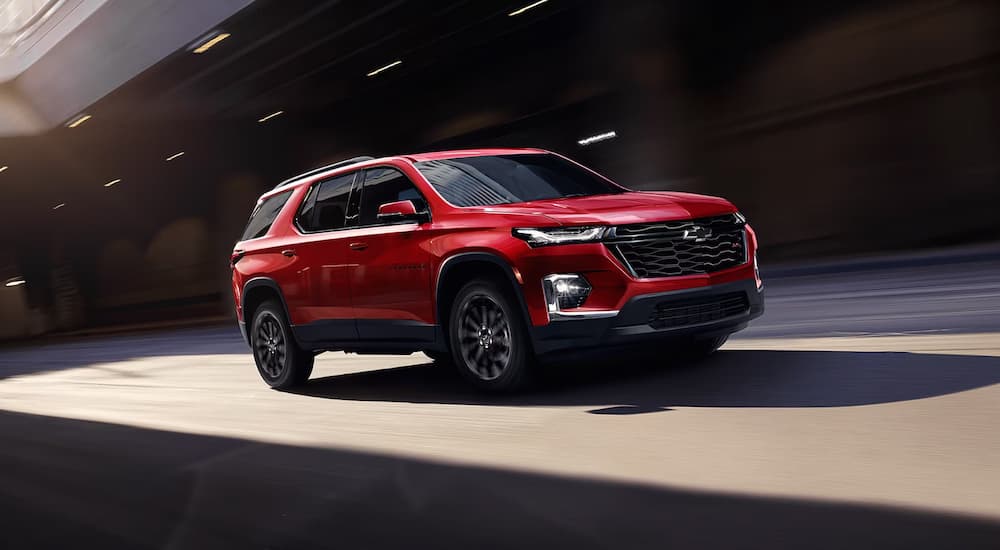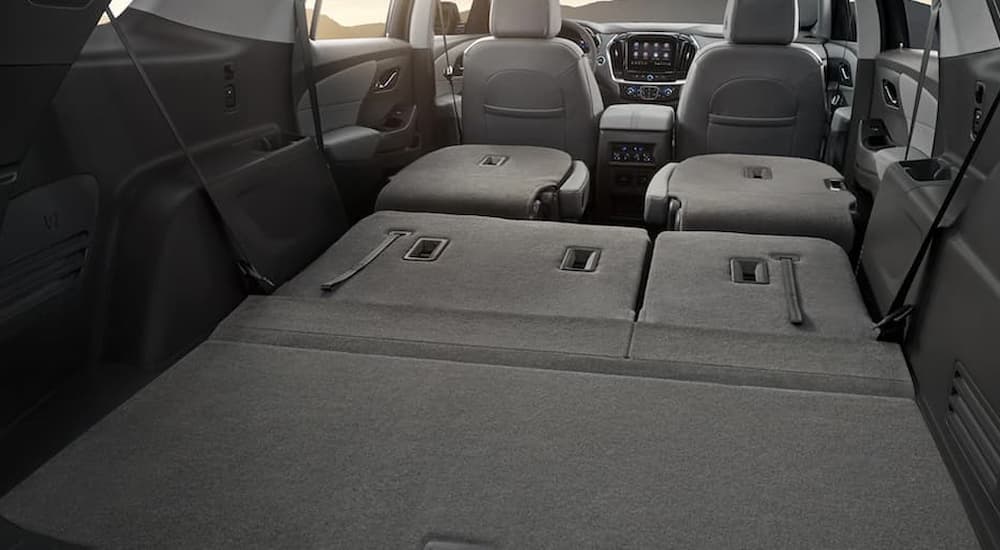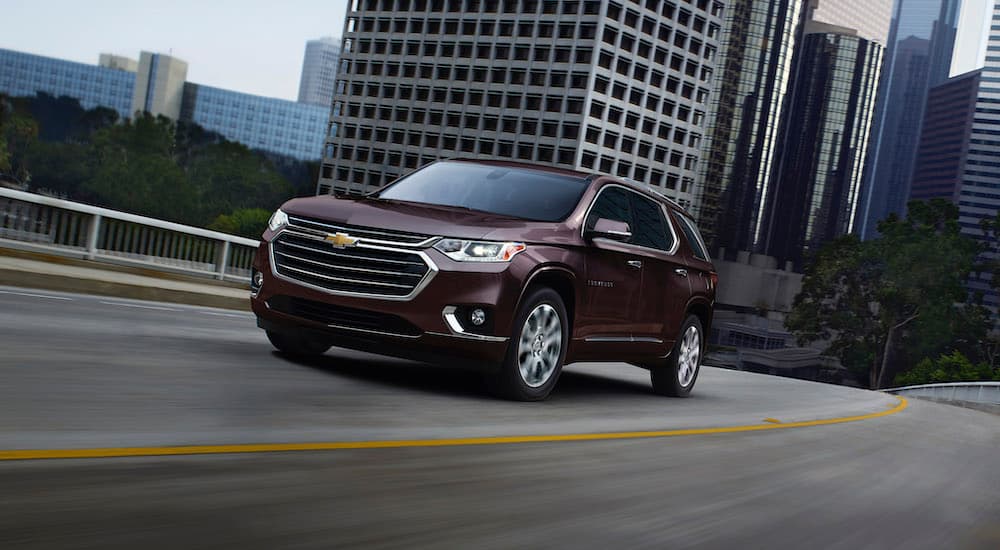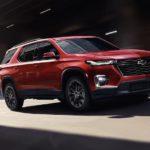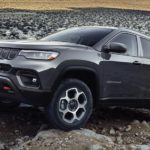Anytime you take to the road, you’re going to see a midsize SUV within a couple of minutes–assuming you’re not already driving one. You can’t miss ‘em. When I glance down my block, I see at least seven midsize SUVs parked… and that’s on a slow day. When I drive by my nearby Chevy dealer, I see the Chevy Traverse for sale and the dealership seems to always be barely keeping up with demand. Customers just can’t get enough. But why?
It’s a good question. Drivers managed to make do, usually by owning more than one car before the midsize craze took the country by storm in the late 1990s and early 2000s. A big sedan like my grandfather used to drive tended to be a common buy for families. To an extent, I miss those old cars: the long Mustangs and Mercedes. A bit of consideration shows why a midsize SUV is more realistic, though. It’s designed to maximize seating and cargo room without taking up as much real estate. Easy to have a nostalgic take on those old sedans, but if push came to shove, I think most of us would opt for the midsize now.
But what about the old station wagons? Didn’t those get the job done? Why’d we leave those behind? Look: there’s a bit of nostalgia there, too. Families regularly packed into those back in the 1980s and 1990s, and the thought of a station wagon might bring back memories of those years, watching Ghostbusters and playing the Super Nintendo. Let’s be honest, though: in terms of appearance, would you really want to opt for a station wagon over a modern midsize SUV? Probably not. And parking it? What a disaster.
The Midsize Is a One-Size-Fits-All
A major factor in favor of midsize models’ continued domination is that they can serve many purposes. Unlike older vehicles, the midsize SUV is designed with a plethora of lifestyles in mind. It can be an SUV for a large family of five, but it can also be an SUV for an athlete who needs to haul around gear. In addition, the family-oriented driver may well be an athlete, too, so now the midsize can serve a dual purpose, eliminating the need for two cars.
Inflation means we all want to save money. Opting for a midsize SUV allows a driver to get a lot of bang for their buck. They don’t need to buy multiple vehicles when a midsize can do almost anything they need.
Picture this: you work in a city but also like to go out into the wilderness on the weekend to do some kayaking or hiking. At first, you sound like the exact type of person who will need two cars. You need one that can manage those tight city streets, where people are parked on both sides of the road whether that’s legal or not (it often seems like other drivers have only a vague familiarity with traffic rules). Then, you need another car that can handle the challenging terrain that you need to traverse when heading out to enjoy the great outdoors.
Yet, a midsize SUV can probably handle both tasks. They’re nimble enough that those city streets do not become impossible to navigate, but they’re also rugged enough that some rough driving doesn’t cause trouble. For a while now, consumers have been going for a midsize for that very reason. Versatility wins out. Sure, they may not find a midsize as exciting as a sports car or pickup truck, in terms of looks, but they also don’t need to buy two cars either.
And speaking of appearance, there’s been a bit of a change there, too…
Midsize SUVs Simply Look Better Now
Maybe it’s just me, although I doubt it, but those early midsize SUVs from around 2000 weren’t exactly beauties on the road. They weren’t hideous, but nor were they something that attracted the eye. Someone who enjoys a social lifestyle, especially a younger person, probably wouldn’t be attracted to a ride that looks so plain.
Flash forward to now, though, and it’s just no longer the case that midsize SUVs have to look drab. Take the previously-mentioned Chevy Traverse as an example. It has a range of colors available for consumers to choose from for the exterior (I’m big on the Radiant Red Tintcoat) and the interior. Plus, for those willing to spend a little more, there are some special editions, such as the Midnight Edition (my preference) and the Redline Edition. Both of these trims ooze a sense of cool. You can fit in with the sportiest of sports cars if you’re riding in one of these special editions.
I say none of this easily: I was absolutely a doubter that midsize SUVs would become aesthetically desirable. But I’m happy to admit I was wrong on this count and I’d proudly drive a Traverse Midnight Edition to any locale. Considering how many midsize models there are on the road these days, I’d say I’m not alone in that.
Improved Power and Capability
One of the great unsung aspects of SUVs is just how much they can tow. Most people I speak to don’t even think about towing when they discuss or consider their midsize SUV. It’s a shame because some midsize models can tow a respectable amount. If we use the Chevy Traverse as an example again, we can see it gives drivers some solid capability: up to 5,000 lbs of towing capacity. That’s a lot more than most people assume!
Whether you’re towing for work or pleasure, you can make life a lot easier by reducing multiple trips to just one with a trailer loaded up. I’m certainly not going to pretend that’s as much as a full-size truck can tow, but it’s considerably more than people tend to assume and likely as much as many drivers need. Combine that with the cargo space midsize SUVs offer, and these models supply a lot of practical options for a wide range of drivers.
Boosted Fuel Efficiency and Hybrids
It’s easy to assume that these midsize SUVs make visits to the gas station frequent and pricey. That’s not the case, though, since many midsize models are designed with fuel efficiency in mind. Manufacturers know how unpredictable gas prices can be and want to make sure that owning a midsize does not become an expensive long-term prospect. Certainly, it’s an unpleasant thought: you buy a midsize SUV at a good price, you’re proud of yourself for getting that cost down, and then (wham!) you’re hit with high gas costs for the next five years.
Luckily, plenty of midsize SUVs deliver surprisingly impressive fuel efficiency. Better yet: you also have hybrid options now. Even the big boys of SUV culture, like the Tahoe, have hybrid options; and in 2023, Chevy is rolling out two fully-electric SUVs. You can reduce your costs over your vehicle’s lifetime by quite a bit if you go with one of these options. Plus, with charging stations spreading across the nation, you won’t need to worry as much when driving a midsize electric vehicle, because you’ll have plenty of charging options during a cross-country journey.
The Midsize Craze Will Continue
Until we get those flying cars, it’s safe to say that midsize SUVs will remain popular (even once they can fly, we’ll probably still flock to them). With such varied abilities, it’s just a smart choice for consumers who no longer have the desire or room to keep two or three cars. Add that capability to their sleeker, appealing designs, and it starts to become a no-brainer to consider a midsize when you head to the dealership for your next purchase. By no means will sedans and pickup trucks vanish, but I suspect the midsize will continue to rule the road in the years to come. Even I, a long-term sedan lover, will be eyeing a midsize SUV when my current ride needs replacing; guess there will be at least eight of them on my block after that.
